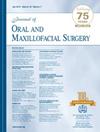抗凝治疗方案对微血管头颈部重建皮瓣预后的影响。
IF 2.3
3区 医学
Q2 DENTISTRY, ORAL SURGERY & MEDICINE
引用次数: 0
摘要
背景:皮瓣重建后血栓的形成会减少血流灌注并导致皮瓣受损。有效的抗凝治疗方案对于预防这种并发症至关重要。目的:本研究的目的是测量和比较3种不同抗凝方案相关的皮瓣损害。研究设计、背景、样本:这项回顾性队列研究包括接受皮瓣重建的头颈癌患者。排除标准包括不同意参与、未接受抗凝治疗方案或有肝素或阿司匹林(ASA)不良反应史的患者。暴露:主要暴露为抗凝方案,分为静脉注射不分离肝素组(IV-UFH)、皮下注射不分离肝素组(SC-UFH)、SC-UFH加ASA 3组。主要转归变量:转归变量为术后皮瓣转归是否受损。协变量:协变量包括患者人口统计学、癌症类型、新辅助治疗、皮瓣类型、手术方式、重症监护病房住院时间、病史和术后并发症。分析:基线数据分析采用χ2、Mann-Whitney U检验和Kruskal-Wallis检验。采用多因素logistic回归来检验抗凝治疗方案与皮瓣预后之间的相关性。P值< 0.05认为有统计学意义。结果:研究样本包括300例符合纳入标准的患者,平均年龄48.3(±17.69)岁,其中男性202例(67.3%)。皮瓣受损28例(9.3%)。未经调整的分析显示,接受IV-UFH的患者皮瓣受损的风险明显高于接受SC-UFH的患者(相对风险:3.43[1.62 ~ 7.28])。在SC-UFH中加入ASA并没有显著降低皮瓣受损的风险(相对风险:0.95[0.35 ~ 2.61])。在调整混杂因素后,抗凝类型与皮瓣受损无关(P = 0.05)。然而,在亚组分析中,与SC-UFH相比,IV-UFH患者皮瓣受损的几率仍然更高(优势比= 2.69,95% CI [1.003 ~ 7.205], P = 0.049)。结论及相关性:头颈部显微手术术后血栓形成仍然是预后不良的重要危险因素。与静脉给药相比,SC-UFH给药可能是管理这些风险的实用方法;然而,抗凝方案的选择与皮瓣受损无关。本文章由计算机程序翻译,如有差异,请以英文原文为准。
The Role of Anticoagulation Regimen on Flap Outcome in Microvascular Head and Neck Reconstruction
Background
Thrombus formation following flap reconstruction reduces perfusion and can lead to flap compromise. Effective anticoagulation protocols are essential to prevent this complication.
Purpose
The study’s purpose was to measure and compare flap compromise associated with 3 different anticoagulation protocols.
Study Design, Setting, Sample
This retrospective cohort study included patients with head and neck cancer who underwent flap reconstruction. Exclusion criteria included patients who did not consent to participate, did not receive the anticoagulation regimen, or had a history of adverse reactions to heparin or aspirin (ASA).
Exposure
The primary exposure was the anticoagulation protocol, which was divided into 3 groups: intravenous unfractionated heparin (IV-UFH), subcutaneous UFH (SC-UFH), and SC-UFH plus ASA.
Main Outcome Variable
The outcome variable was postoperative flap outcome coded as compromised or not.
Covariates
Covariates included patient demographics, cancer type, neoadjuvant therapy, flap type, surgical procedure, intensive care unit stay, medical history, and postoperative complications.
Analyses
χ2, Mann–Whitney U, and Kruskal–Wallis tests were used for baseline data analysis. Multivariate logistic regression was conducted to examine the adjusted association between anticoagulation protocol and flap outcome. P values < .05 were considered statistically significant.
Results
The study sample consisted of 300 patients who met inclusion criteria with a mean age of 48.3 (±17.69) years, 202 (67.3%) of whom were male. There were 28 (9.3%) cases of flap compromise. The unadjusted analysis showed that patients receiving IV-UFH had a significantly higher risk of flap compromise compared to those receiving SC-UFH (relative risk: 3.43 [1.62 to 7.28]). Adding ASA to SC-UFH did not result in a statistically significant reduction in the risk of flap compromise (relative risk: 0.95 [0.35 to 2.61]). After adjusting for confounding factors, the anticoagulant type was not associated with flap compromise (P = .05). However, in the subgroup analysis, compared to SC-UFH, subjects receiving IV-UFH still had higher odds of flap compromise (odds ratio = 2.69, 95% CI [1.003 to 7.205], P = .049)
Conclusion and Relevance
Postoperative thrombosis in head and neck microsurgery remains a significant risk factor for poor outcomes. SC-UFH administration may be a practical approach to managing these risks compared to intravenous administration; however, the choice of anticoagulation protocol is not associated with the flap compromise.
求助全文
通过发布文献求助,成功后即可免费获取论文全文。
去求助
来源期刊

Journal of Oral and Maxillofacial Surgery
医学-牙科与口腔外科
CiteScore
4.00
自引率
5.30%
发文量
0
审稿时长
41 days
期刊介绍:
This monthly journal offers comprehensive coverage of new techniques, important developments and innovative ideas in oral and maxillofacial surgery. Practice-applicable articles help develop the methods used to handle dentoalveolar surgery, facial injuries and deformities, TMJ disorders, oral cancer, jaw reconstruction, anesthesia and analgesia. The journal also includes specifics on new instruments and diagnostic equipment and modern therapeutic drugs and devices. Journal of Oral and Maxillofacial Surgery is recommended for first or priority subscription by the Dental Section of the Medical Library Association.
 求助内容:
求助内容: 应助结果提醒方式:
应助结果提醒方式:


